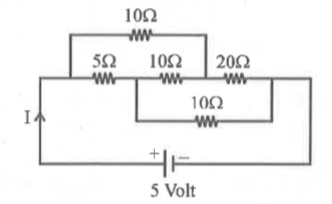For an LCR circuit, the power transferred from the driving source to the driven oscillator is P=I2Zcosϕ.
the power factor cosϕ≥0,P≥0
the driving force can give no energy to the oscillator(P = 0) in some cases.
the driving force cannot syphon out (P<0) the energy out of oscillator.
all of these.
The correct Answer is:D
Here, P=I2Zcosϕ
(a) If power factor cosϕ≥0⇒P≥0
(b) For wattless component the driving force shall give no energy to the oscillator, so, at ϕ=90∘,P=0.
(c ) The driving force cannot syphon out the energy out of oscillator. i.e. P cannot be negative.
Hence all options are correct.
Topper's Solved these Questions
- ALTERNATING CURRENT BOOK - NCERT FINGERTIPSCHAPTER - ALTERNATING CURRENT EXERCISE - Lc Oscillations
9 Videos
- ALTERNATING CURRENT BOOK - NCERT FINGERTIPSCHAPTER - ALTERNATING CURRENT EXERCISE - Transformers
16 Videos
- ALTERNATING CURRENT BOOK - NCERT FINGERTIPSCHAPTER - ALTERNATING CURRENT EXERCISE - Ac Voltage Applied To A Series Lcr Circuit
28 Videos
- ATOMS BOOK - NCERT FINGERTIPSCHAPTER - ATOMS EXERCISE - Assertion And Reason
15 Videos
Similar Questions
In the adjoining circuit, the current I drawn from the 5 volt source will be

View SolutionA series LCR circuit with L=0.125/πH,C=500/πnF,R=23Ω is connected to a 230V variable frequency supply. (a)What is the source frequency for which current amplitudes is maximum? Obtain this maximum value. (b)What is the source frequency for which average power absorbed by the circuit is maximum ?Obtain the value of this maximum power.(c )For what reactangle of the circuit, the power transferred to the circuit is half the power at resonance?What is the current amplitude at this reactangle ? (d)if ω is the angular frequency at which the power consumed in the circuit is half the power at resonance, write an expression for ω (e)What is the Q-factor (Quality factor) of the given circuit?
View Solution
Knowledge Check
A: In a forced oscillator the energy transferred from driving force to damped oscillator is maximum in resonance state.
R: The amplitude of forced oscillator depends on the frequency of external force.AIf both Assertion & Reason are true and the reason is the correct explanation of the assertion, then mark (1)BIf both Assertion & Reason are true but the reason is not the correct explanation of the assertion, then mark (2)CIf Assertion is true statement but Reason is false then mark (3)DIf both Assertion and Reason are false statements, then mark (4)For an AC circuit V=15sinωt and I=20cosωt the average power consumed in this circuit is
A300 wattB150 wattC75 wattDzeroFor an ac circuit V=15sinωt and I=20cosωt the average power consumed in this circuit is
A300 wattB150 wattC75 wattDzero
A series LCR circuit with L=0.12H,C=480nF, and R=23 Omega is connected to a 230-V variable frequency supply.
(a) What is the source frequency for which current amplitude is maximum? Find this maximum value.
(b) What is the source frequency for which average power absorbed by the circuit is maximum? Obtain the value of maximum power.
(c ) For which frequencies of the source is the power transferred to the circuit half the power at resonant frequency?
(d) What is the Q-factor of the circuit?
View SolutionA series LCR circuit with L = 0.12 H, C = 480 nF, R = 232 is connected to a 230 V variable
frequency supply.
(a) What is the source frequency for which current amplitude is maximum ? Obtain this maximum value.
(b) What is the source frequency for which average power absorbed by the circuit is maximum ? Obtain the value of this maximum power.
(c) For which frequencies of the source is the power transferred to the circuit half the power at resonant frequency ? What is the current amplitude at these frequencies? (d) What is the Q-factor of the given circuit ?
View SolutionA series LCR circuit with r=10ohm,L=2H and C=25μF is connected to a varialbe frequency 200 V a.c. supply. When the frequency of the supply equals the natural frequency of the circuit, what is the average power transferred to the circuit in one complete cycle ?
View SolutionA certain oscillation results from the addition of coherent oscillations of the same direction y=acos[ωt+(k−1)ϕ] where k is the number of oscillation [ k=1,2………N] and ϕ is the phase difference between kthand(K−1)th oscillations. The amplitude of resultant oscillation will be
View SolutionAn AC source of variable frequency f is connected to an LCR series circuit. Which one of the graphs in figure represents the variation of current of current I in the circuit with frequency f?
View Solution
